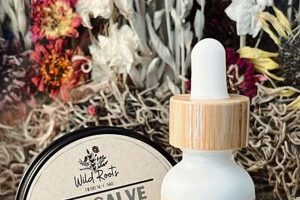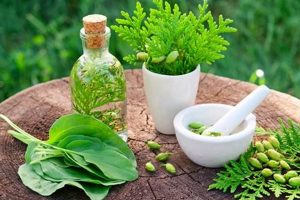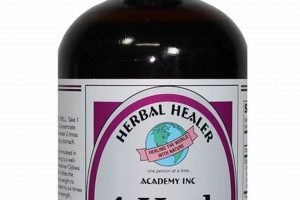A beverage combining various plant-derived ingredients traditionally believed to alleviate symptoms associated with upper respiratory infections, offers a natural approach to wellness. Common ingredients include ginger, known for its anti-inflammatory properties, and peppermint, often used to ease congestion. The specific formulation varies, reflecting regional herbal traditions and intended therapeutic effects.
Historically, such concoctions have held a prominent place in many cultures, often serving as readily accessible remedies. The perceived benefits stem from the inherent properties of the plants, including potential antioxidant, antiviral, and immune-boosting actions. While it is not a substitute for medical treatment, it may provide soothing comfort and support the body’s natural defenses during periods of illness.
The subsequent sections will delve into the selection of optimal ingredients, preparation methods ensuring maximum efficacy, potential side effects, and relevant scientific studies supporting its use. Understanding these aspects provides a more complete picture of its potential benefits and limitations.
Tips for Optimizing Herbal Cold Care
Maximizing the potential benefits requires careful consideration of ingredient selection, preparation techniques, and usage guidelines.
Tip 1: Select High-Quality Ingredients: Opt for certified organic or sustainably sourced herbs to minimize exposure to pesticides and ensure potency. Dried herbs should exhibit vibrant color and a strong aroma.
Tip 2: Prioritize Known Therapeutic Herbs: Research specific herbs known for their antiviral, anti-inflammatory, or decongestant properties, such as elderflower, echinacea, or licorice root.
Tip 3: Employ Proper Steeping Techniques: Utilize appropriate water temperature and steeping times to extract maximum therapeutic compounds. Boiling water can degrade delicate herbs; aim for simmering. A 10-15 minute steep is often recommended.
Tip 4: Consider Synergistic Combinations: Combine herbs with complementary actions to enhance overall efficacy. For instance, pairing an anti-inflammatory herb with a demulcent (soothing) herb can provide comprehensive relief.
Tip 5: Adjust Dosage Based on Individual Needs: Start with a lower dosage and gradually increase as needed, while monitoring for any adverse reactions. Children, pregnant women, and individuals with pre-existing conditions should consult a healthcare professional before use.
Tip 6: Maintain Hydration: While beneficial, it serves as an adjunct to adequate fluid intake. Ensure consumption of water and other hydrating fluids throughout the day to support overall recovery.
Tip 7: Understand Potential Interactions: Be aware of potential interactions with prescription medications or existing health conditions. Certain herbs can affect blood clotting, blood pressure, or blood sugar levels.
By adhering to these recommendations, individuals can increase the likelihood of experiencing the intended benefits, while minimizing potential risks.
The subsequent section will address potential side effects and contraindications, providing a balanced perspective on its use.
1. Ingredient Sourcing
The origin and quality of the herbs profoundly affect the efficacy and safety. Sourcing methods dictate the concentration of active compounds within the plant material. For example, herbs grown in nutrient-rich soil, under optimal sunlight, and harvested at peak maturity exhibit higher levels of essential oils and medicinal constituents. Conversely, herbs cultivated with pesticides or sourced from polluted environments may contain harmful residues, negating potential therapeutic benefits and potentially introducing toxins. The choice between wildcrafted, organically grown, or conventionally farmed herbs directly influences the overall quality.
Consider the case of ginger. Ginger sourced from regions known for their cultivation expertise, such as certain areas of Asia, often contains a higher concentration of gingerol, a key anti-inflammatory compound. Conversely, mass-produced ginger may be cultivated rapidly, resulting in lower gingerol levels. Similarly, the processing methods employed after harvesting significantly impact the final product. Improper drying or storage can lead to degradation of active constituents, reducing the overall potency. Transparency in sourcing, including certifications and lab testing for purity and potency, ensures a higher-quality end product.
Therefore, diligent attention to ingredient sourcing represents a critical step in maximizing the potential benefits and minimizing risks. Prioritizing reputable suppliers, scrutinizing certifications, and understanding cultivation practices are essential for informed consumers. The commitment to quality sourcing directly translates to a more effective and safer product. Without careful consideration of the source, the intended therapeutic effects may be compromised, or unintended adverse effects could occur, thereby undermining the core purpose of this natural remedy.
2. Preparation Methods
The method of preparation directly influences the extraction and bioavailability of bioactive compounds from the constituent herbs. Improper preparation can result in suboptimal extraction, leading to a less effective remedy, while appropriate techniques maximize the release of therapeutic agents. Temperature, steeping time, and the type of solvent (typically water) are crucial variables. For instance, volatile oils present in herbs like peppermint are readily lost at high temperatures, diminishing their decongestant properties. Over-boiling can also degrade delicate compounds, such as certain flavonoids and polysaccharides, which contribute to immune-modulating effects. Conversely, under-extraction leaves beneficial constituents trapped within the plant material, resulting in an underpowered brew.
Specific herbs necessitate tailored preparation methods. For roots and barks, a decoction simmering the herbs in water for an extended period is often required to break down tough cell walls and release their constituents. In contrast, flowers and leaves generally require a shorter infusion steeping in hot water to prevent the loss of volatile oils and delicate compounds. The fineness of the herb material also matters. Coarsely ground herbs expose less surface area, reducing the extraction rate compared to finely ground or powdered herbs. The vessel used for preparation, whether glass, ceramic, or stainless steel, can also impact the process, though its effect is typically less significant than temperature and steeping time. Utilizing distilled or filtered water minimizes the presence of minerals that could potentially interact with the herbal constituents.
Therefore, a thorough understanding of the ideal preparation methods is paramount for unlocking the full therapeutic potential. A failure to understand how each herb releases its beneficial properties could cause the end result to be drastically different from intended. Careful attention to temperature, steeping time, and herb type, guided by established herbal practices, ensures the most effective extraction and a more potent final product. Ignorance of these preparation method concepts and processes result in limited success with herbal cold care teas.
3. Symptom relief
The primary objective in utilizing herbal cold care tea is the alleviation of symptoms associated with upper respiratory infections. The efficacy in providing symptom relief varies depending on the specific herbs employed and the individual’s physiological response.
- Decongestant Action
Certain herbal constituents possess decongestant properties, helping to relieve nasal congestion. For example, peppermint and eucalyptus, often included in formulations, contain volatile oils that can thin mucus and promote drainage. The effectiveness depends on the concentration of these oils and individual sensitivity. Nasal passages become more open which supports breathing freely again.
- Anti-inflammatory Effects
Inflammation of the respiratory tract contributes to various symptoms. Herbs like ginger and chamomile contain compounds that may reduce inflammation, easing sore throats and coughs. This reduction can lead to diminished pain and discomfort. Continued use of such herbs may help maintain a balanced inflammatory response.
- Cough Suppression
Some herbs exhibit antitussive properties, helping to suppress coughing. Licorice root, for instance, contains compounds that can soothe irritated airways and reduce the urge to cough. The duration and severity of cough episodes may decrease as a result. Reduced coughing can improve sleep quality and reduce fatigue.
- Immune Support
Certain herbs are thought to support the immune system, aiding the body’s natural defenses against viral or bacterial infections. Echinacea and elderberry are frequently cited for their potential to stimulate immune cell activity. Improved immune function can lead to a quicker recovery and reduced symptom duration. This also minimizes the likelihood of secondary infections.
The ability of herbal cold care tea to provide effective symptom relief stems from the combined action of these different properties. While anecdotal evidence and traditional use support their efficacy, clinical research is ongoing to further elucidate the mechanisms and validate the extent of symptom reduction. Individual results can vary, and herbal remedies are generally considered a complementary approach to conventional medical care rather than a replacement.
4. Potential Interactions
The combination of herbal remedies, including preparations intended for alleviating cold symptoms, with pharmaceutical drugs or pre-existing medical conditions presents a significant risk of adverse interactions. Understanding and addressing these potential interactions is crucial for ensuring patient safety and therapeutic efficacy.
- Herb-Drug Interactions
Herbs contain bioactive compounds that can influence drug metabolism, absorption, and excretion. For example, St. John’s Wort, while not typically included in common cold remedies, is a potent inducer of CYP3A4 enzymes, accelerating the metabolism of numerous drugs, including certain antiviral medications. Even seemingly benign ingredients like licorice root can interfere with the effectiveness of medications for hypertension or heart conditions. This potential for pharmacokinetic interaction can lead to decreased drug efficacy or increased toxicity. The simultaneous use of herbal products and prescription medication should be approached with caution and under the guidance of a qualified healthcare provider.
- Interactions with Medical Conditions
Certain herbs can exacerbate existing medical conditions. Individuals with autoimmune disorders should exercise caution when using immune-stimulating herbs like echinacea, as they may trigger or worsen autoimmune responses. Similarly, people with bleeding disorders should avoid herbs that possess anticoagulant properties, such as ginger and garlic, as these may increase the risk of bleeding events, especially when combined with anticoagulant or antiplatelet medications. Prior medical history and current health status significantly influence the suitability and safety of herbal remedies.
- Additive Effects
The combination of herbs with similar pharmacological actions can lead to additive effects, potentially resulting in excessive physiological responses. For example, combining multiple herbs with sedative properties, such as chamomile and valerian, with alcohol or other central nervous system depressants can significantly increase the risk of drowsiness, impaired coordination, and respiratory depression. Careful consideration should be given to the cumulative effects of different herbs and medications to avoid over-suppression of physiological functions.
- Allergic Reactions
Individuals may develop allergic reactions to specific herbs, ranging from mild skin rashes to severe anaphylaxis. Pre-existing allergies to plants within the same botanical family as the herb in question increase the risk of cross-reactivity. For example, individuals allergic to ragweed may also exhibit allergic reactions to chamomile or echinacea. Thorough review of individual allergy history and awareness of potential cross-reactivity is essential for preventing allergic reactions and ensuring safe use of herbal remedies.
These potential interactions underscore the importance of transparency and communication between patients and healthcare providers regarding the use of herbal remedies. A comprehensive medical history, including all medications, supplements, and pre-existing conditions, enables healthcare professionals to assess the risk of potential interactions and provide informed guidance on the safe and effective use of herbal products. Neglecting to consider potential interactions can have significant and potentially detrimental consequences for patient health.
5. Traditional Applications
The lineage of herbal cold care preparations traces back centuries, deeply rooted in diverse cultural practices worldwide. Traditional applications inform current formulations, acting as a foundational knowledge base for selecting and combining herbs believed to alleviate cold symptoms. The effectiveness, as perceived within these traditional systems, rests upon consistent application and observation of outcomes over generations, often predating modern scientific validation. For instance, the use of elderflower in European traditions to combat respiratory ailments has spurred contemporary research into its antiviral properties. Similarly, the historical use of ginger in Asian medicine for its anti-inflammatory effects provides a basis for its inclusion in many contemporary cold remedies. These time-honored applications, while not conclusive scientific evidence, represent a wealth of empirical data regarding the perceived benefits and safety profiles of various herbs.
The practical significance of understanding traditional applications lies in its ability to guide informed decision-making regarding the selection and use of herbal cold care teas. Recognition of cultural variations in herbal use patterns allows for tailoring formulations to specific symptom profiles and individual needs. For example, a traditional Chinese medicine approach might emphasize herbs that address both cold symptoms and underlying energetic imbalances, whereas an Ayurvedic approach might focus on balancing the body’s doshas to restore equilibrium. This knowledge also offers a framework for assessing potential risks and contraindications, as traditional systems often document observed adverse effects or limitations associated with particular herbs or combinations. However, it is crucial to acknowledge the limitations of relying solely on traditional knowledge, as variations in preparation methods, environmental factors, and individual constitutions can influence outcomes.
In summary, traditional applications provide a valuable historical context and experiential foundation for understanding and utilizing herbal cold care teas. Recognizing the connection between historical practices and contemporary formulations facilitates informed decision-making, allowing for tailored approaches to symptom management. While traditional knowledge offers insights into the potential benefits and risks of various herbs, it should be integrated with modern scientific research to ensure safe and effective use. The challenge lies in bridging the gap between traditional wisdom and scientific validation to optimize the therapeutic potential of herbal cold care preparations.
Frequently Asked Questions
The following addresses prevalent inquiries concerning herbal preparations designed to alleviate cold symptoms, offering clarity based on established knowledge and research.
Question 1: Is herbal cold care tea a substitute for medical treatment?
No. While it may provide symptomatic relief and support the body’s natural defenses, it does not replace professional medical evaluation or treatment for upper respiratory infections. Individuals experiencing severe or persistent symptoms should seek medical advice.
Question 2: Can herbal cold care tea prevent the common cold?
There is limited scientific evidence to support the claim that it definitively prevents colds. Certain ingredients, such as elderberry, may possess antiviral properties, but more research is required to determine their effectiveness in preventing infection. Its consumption is most beneficial once symptoms begin.
Question 3: Are there potential side effects associated with herbal cold care tea?
Yes. Potential side effects vary depending on the specific herbs used. Some individuals may experience allergic reactions, digestive upset, or interactions with medications. Consulting a healthcare professional before consumption is advisable, particularly for those with pre-existing medical conditions or those taking prescription drugs.
Question 4: How often should one consume herbal cold care tea?
Frequency of consumption depends on individual needs and tolerance. Generally, two to three cups per day during periods of active cold symptoms are considered a reasonable guideline. Exceeding this amount may increase the risk of adverse effects. Careful consideration should be given to the concentration of herbs in each cup.
Question 5: Is herbal cold care tea safe for children and pregnant women?
Certain herbs are contraindicated for children and pregnant women. Some may pose risks to fetal development or infant health. It is imperative to consult a pediatrician or obstetrician before administering herbal remedies to these populations. Safety profiles vary significantly depending on the herbal constituents.
Question 6: How does one ensure the quality and purity of herbal cold care tea ingredients?
Select certified organic or sustainably sourced herbs from reputable suppliers. Verify that the products have undergone third-party testing for contaminants and potency. Scrutinize labels for accurate ingredient listings and expiration dates. Prioritize whole, unprocessed herbs over heavily processed extracts.
In summary, its efficacy and safety depend on informed selection, responsible use, and awareness of potential interactions. Consultation with a healthcare professional is recommended to personalize recommendations and minimize risks.
The subsequent section will address proper storage techniques for herbal cold care tea and its constituent ingredients.
Conclusion
This article has explored various facets of herbal cold care tea, encompassing ingredient sourcing, preparation methods, symptom relief potential, potential interactions, and traditional applications. The information presented underscores the importance of informed decision-making when utilizing this natural remedy. While it can offer symptomatic relief and potentially support the body’s natural defenses, it is not a panacea and should not replace conventional medical treatment.
A comprehensive understanding of the herbs used, their potential effects, and possible interactions with medications is crucial for safe and effective use. Further research is warranted to fully elucidate the efficacy and mechanisms of action of various herbal combinations. Ultimately, responsible and informed usage will ensure that herbal cold care tea serves as a valuable component of an individual’s overall wellness strategy.







